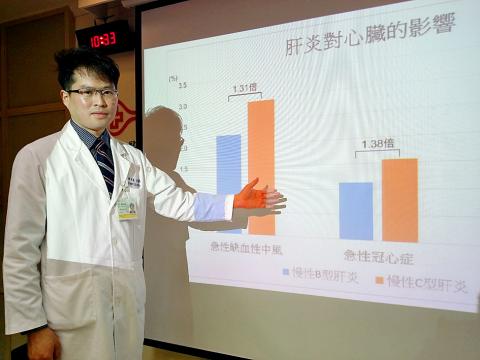Doctors at Chang Gung Memorial Hospital in Taipei on Thursday warned that people with chronic hepatitis B or C should watch for signs of cardiovascular disease, especially heart attacks.
Cardiologist Wu Chien-chia (吳健嘉) said that the hospital admitted a 62-year-old man surnamed Chang (張) who complained of sweating at night and chronic chest pain.
Chang had no medical history of the “three hypers” — hyperlipidemia, hyperglycemia and hypertension — but is a carrier of hepatitis C, Wu said.

Photo: Wu Liang-chi, Taipei Times
Evidence shows that chronic hepatitis can lead to a heart attack from atherosclerosis, he said.
A six-and-a-half-year study surveyed the National Health Insurance records of 12,000 hepatitis B and C carriers, tracking the condition of their arteries, he said.
The study showed that people with chronic hepatitis C were 1.3 times more likely to develop acute coronary syndrome and acute ischemic stroke — characterized by a sudden loss of blood circulation in the brain — and had a mortality rate 1.48 times that of people with hepatitis B, Wu said.
While the data did not show that people with chronic hepatitis B exhibit a significantly greater chance of a heart attack, there was still debate over the matter among medical experts, he said.
The study also showed that people with chronic hepatitis C are 1.77 times more susceptible to severe dysrhythmia, Wu added.
People with chronic hepatitis B were more prone to cirrhosis and 100 times more susceptible to liver cancer than non-carriers, Wu said.
While hepatitis C is treatable, Wu said that people who do not recover within six months could develop chronic conditions, with 5 to 20 percent developing cirrhosis in 15 to 20 years.
About 15 percent of those people die from cirrhosis or liver cancer, he said, adding that people should get regular checkups and adhere to doctors’ advice regarding treatment.

Beijing could eventually see a full amphibious invasion of Taiwan as the only "prudent" way to bring about unification, the US Department of Defense said in a newly released annual report to Congress. The Pentagon's "Annual Report to Congress: Military and Security Developments Involving the People's Republic of China 2025," was in many ways similar to last year’s report but reorganized the analysis of the options China has to take over Taiwan. Generally, according to the report, Chinese leaders view the People's Liberation Army's (PLA) capabilities for a Taiwan campaign as improving, but they remain uncertain about its readiness to successfully seize

HORROR STORIES: One victim recounted not realizing they had been stabbed and seeing people bleeding, while another recalled breaking down in tears after fleeing A man on Friday died after he tried to fight the knife-wielding suspect who went on a stabbing spree near two of Taipei’s busiest metro stations, Taipei Mayor Chiang Wan-an (蔣萬安) said. The 57-year-old man, identified by his family name, Yu (余), encountered the suspect at Exit M7 of Taipei Main Station and immediately tried to stop him, but was fatally wounded and later died, Chiang said, calling the incident “heartbreaking.” Yu’s family would receive at least NT$5 million (US$158,584) in compensation through the Taipei Rapid Transit Corp’s (TRTC) insurance coverage, he said after convening an emergency security response meeting yesterday morning. National

Taiwan has overtaken South Korea this year in per capita income for the first time in 23 years, IMF data showed. Per capita income is a nation’s GDP divided by the total population, used to compare average wealth levels across countries. Taiwan also beat Japan this year on per capita income, after surpassing it for the first time last year, US magazine Newsweek reported yesterday. Across Asia, Taiwan ranked fourth for per capita income at US$37,827 this year due to sustained economic growth, the report said. In the top three spots were Singapore, Macau and Hong Kong, it said. South

Taiwan is getting a day off on Christmas for the first time in 25 years. The change comes after opposition parties passed a law earlier this year to add or restore five public holidays, including Constitution Day, which falls on today, Dec. 25. The day marks the 1947 adoption of the constitution of the Republic of China, as the government in Taipei is formally known. Back then the Chinese Nationalist Party (KMT) governed China from Nanjing. When the KMT, now an opposition party in Taiwan, passed the legislation on holidays, it said that they would help “commemorate the history of national development.” That